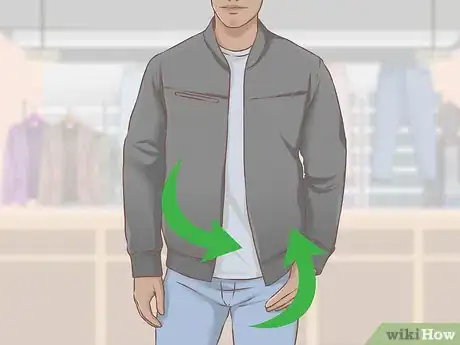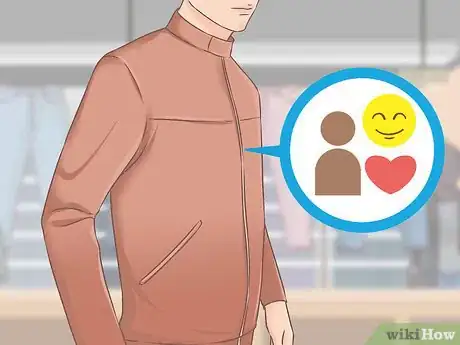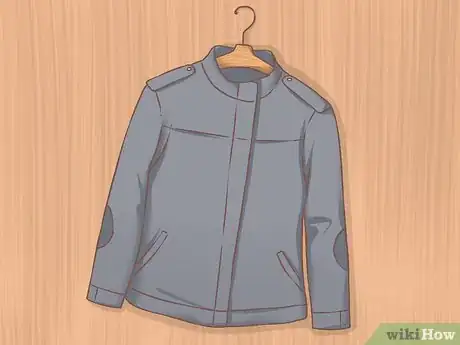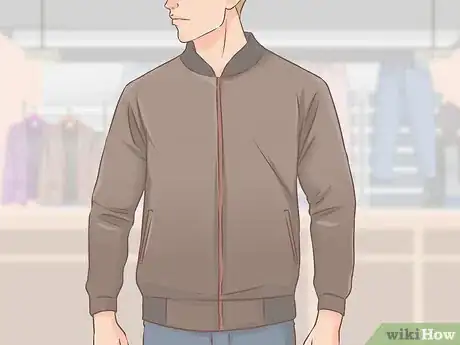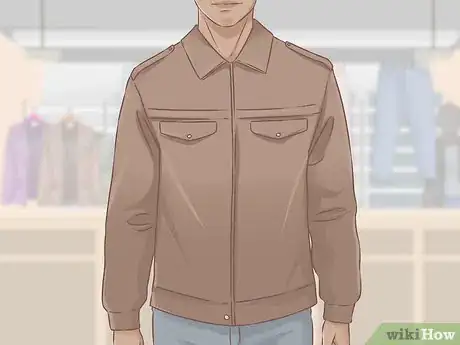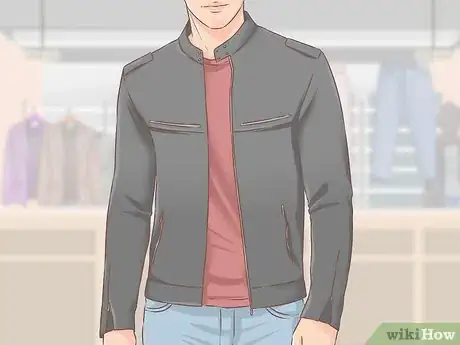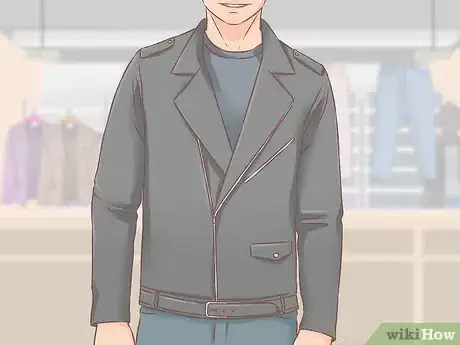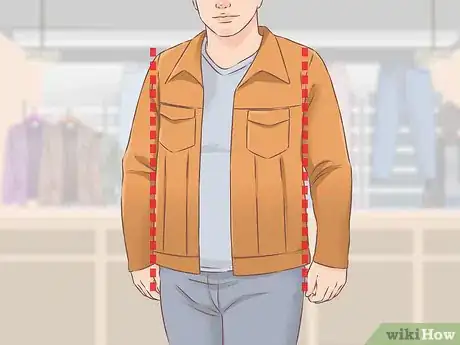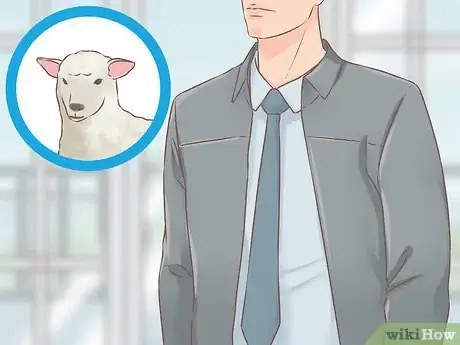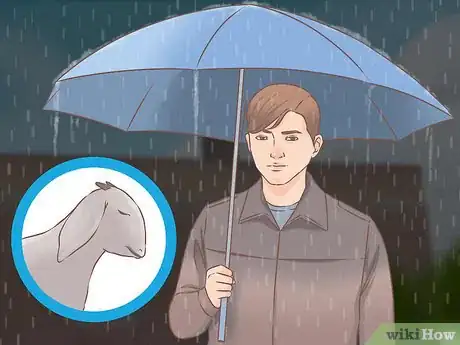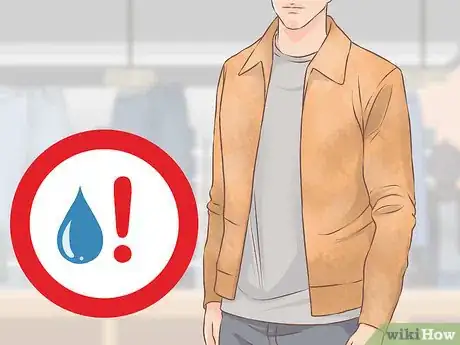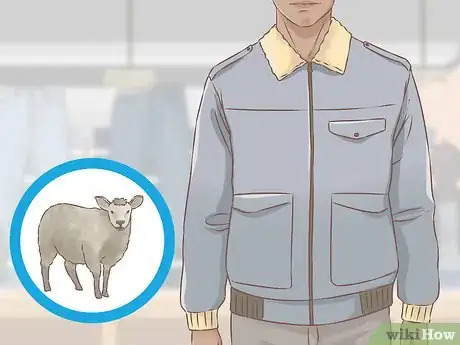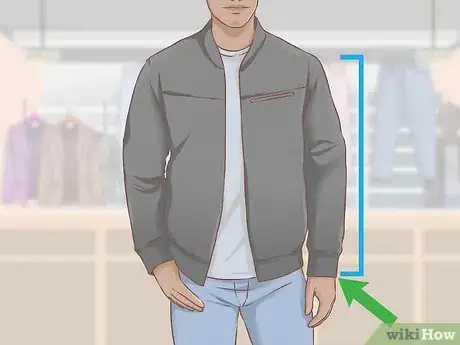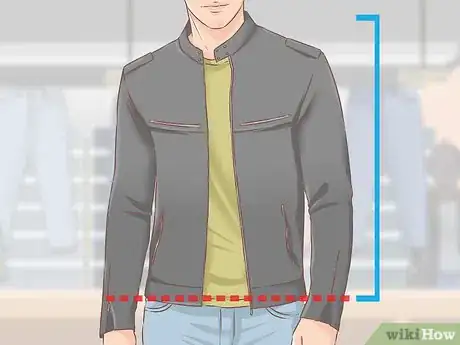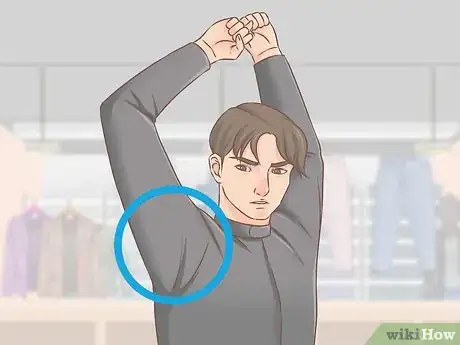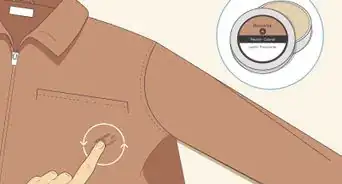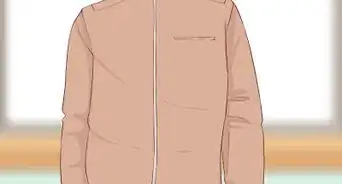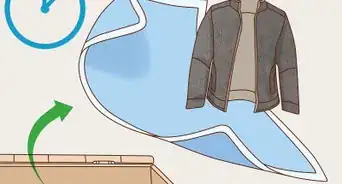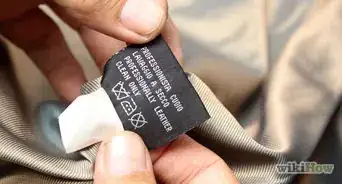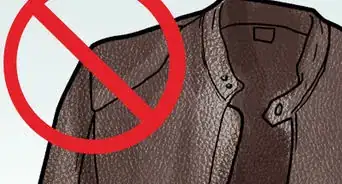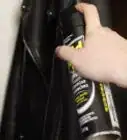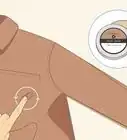This article was co-authored by Kara Allan. Kara Allan is a Celebrity Stylist, Makeup Artist, Personal Brand Consultant, and Owner of Style by Kara Allan. With over 19 years of experience, her expertise includes wardrobe styling and edits, personal shopping, personal branding, makeup application, and corporate image consulting. Kara has worked with many celebrity clients including Leonardo di Caprio and Jesse Itzler. She has also been featured in numerous media outlets such as DC Magazine, Washington Post Express, and the Huffington Post. Kara received her training with Stacy London, Former Fashion Editor at Vogue Magazine and Star of TLC's What Not to Wear, and Carla Mathis, Certified Image Master, Association of Image Consultants International.
This article has been viewed 131,083 times.
Whether you’re shopping for yourself or for a gift, finding the ideal leather jacket might seem daunting. But don’t let this scare you! If you consider a few important factors, you can find the optimal jacket. Determine the style you’re going for, choose the color and skin of your preference, and pick the one that fits and flatters your body type the most!
Steps
Picking the Color
-
1Consider a neutral color that matches your wardrobe. This will allow you to wear the jacket regularly over most of your clothing ensembles. For example, buy a black jacket if the majority of your clothes are bright in color, or are mostly black and white. Buy a brown jacket if your clothes are in earth tones, such as beige or tan.[1]
- Avoid light colors if you’re going to use the jacket daily or in bad weather conditions, as it might get dirty easily.
-
2Pick a color that aligns with your personality. Beyond anything, it’s important to feel comfortable and confident in a leather jacket. For example, don't buy a bright orange leather jacket if you think you may feel self-conscious wearing it out in public later on.
- If you think the color red reflects your vibrant character and you don’t mind standing out, go for a red leather jacket.
- If purple is your favorite color and also matches the purple dye in your hair, that might be a great choice. It’s all about finding your personal color scheme and feeling confident in your jacket!
Advertisement -
3Buy a black jacket for both business and casual wear. Black can "dress up" your business attire and give it a professional appearance. On the other hand, it also denotes a casual appearance when worn with jeans or slacks. If you’re looking for a versatile jacket, black is a safe choice.
Choosing Your Style
-
1Get a bomber jacket if you’re lean and have broad shoulders. Bomber “flight” jackets have extra room in the chest area and will usually fit snugly around your waist. If you have a thick midsection, a bomber jacket may cause you to appear bulkier, especially since most contain thick padding or a lining made of fleece or sheepskin.[2]
-
2Buy a casual biker jacket if you’re tall. Motorcycle or biker jackets typically contain several visual effects such as zippers and pockets that can overwhelm the frame of men typically considered to be short. With a large collar and wide lapels, a biker jacket is probably the most casual style, and can form a great combination with jeans.
- If you’re looking for simplicity, try to find ones that aren’t filled with accessories like buckles and zippers.
-
3Go for a racer jacket for a sporty look. Also known as the “motocross” jacket, this style was originally designed for motorcycle racers, emphasizing versatility as opposed to accessories like zippers and pockets. Due to its figure-hugging quality, it’s best when worn with thin layers underneath.[5]
- It might not be the ideal choice if you have a bulky midsection, as it might be too tight there.
-
4Try a double-rider motorcycle jacket for a classic “bad boy” look. The style Marlon Brando made famous in The Wild Ones, the double-rider has been a classic icon of all leather jackets. With its large lapels, flared collar, and the front zipper running at an angle, this jacket often reflects a rough and manly image.[6]
-
5Buy a jacket with an elastic waistband if you’re on the skinny side. An elastic waistband can cinch snugly below your stomach. The elastic waistband will emphasize your upper chest and shoulders and may help you look more built if that’s what you’re going for.[7]
-
6Pick a straight, streamlined jacket if your midsection is bulky. Straight jackets may help eliminate the padded look around your midsection area, while jackets with elastic waistbands and other adornments, such as zippers and multiple pockets, may accentuate your thickness.[8]
Picking the Right Skin
-
1Get lambskin for a soft and elegant feel. Lambskin is the softest leather you can commonly find, and its silky feel gives it a smooth look. Choose this type of leather if you’ll use the jacket for fancy or professional occasions and want to appear a little dressed up. Keep in mind that it is not as durable as some other types of leather.[9]
-
2Go for cow or horse leather if you’ll go on many outdoor adventures. Known for their durability, cow and horse leathers are both great options if you’ll be wearing your jacket in cold weather, or on a motorcycle. Cow leather is more commonly available than horse leather, which tends to be slightly stiffer.[10]
- Choose calfskin (from a younger cow) if you want a softer version of cow leather.
-
3Pick goatskin for rainy days. With its high durability and water-repellent characteristics, goatskin is a great choice if you’re planning on wearing the jacket during rainy or snowy weather. It’s similar to lambskin, except that it’s not as smooth and soft. Goatskin can be best identified by its pebbly appearance.[11]
-
4Avoid suede if you think you might get your jacket wet. Suede, often made from lamb or goat skin, can look elegant, but is definitely not water-friendly. If you get your suede jacket wet, it’ll likely get very hard when it dries. It’s best to save suede for indoor activities.[12]
-
5Pick sheepskin for a fuzzy and versatile shearling jacket. Lighter than goatskin or cowskin, sheepskin is mostly used for shearling jackets. Shearlings contain a suede surface on one side, and a furry surface on the other, made from the wool of the sheep. The advantage is that you can wear them with either surface out, depending on your mood or the weather.
-
6Look for kangaroo or crocodile skin if you prefer an exotic look. Although they are fairly uncommon, you can find kangaroo or crocodile skin, which will make you stand out by their unique and exotic texture, but will cost much more than cow or lambskin. Kangaroo skin is much thinner and tougher than cow leather, and crocodile skin has large rectangular tile patterns.[13]
Figuring out the Right Fit
-
1Figure out your measurements before shopping. To find the right fit more easily, it’s best to take your measurements (or have them taken at a store) before beginning to shop. Use a measuring tape to find your shoulder, sleeve, chest, waist, and torso measurements.[14]
- Shoulders: Extend the tape from the joint where your shoulder meets your arm to the other joint.
- Sleeves: Let your arm fall naturally, and measure from the joint of your shoulder to the bottom joint of your thumb.
- Chest: Find where your chest is the widest—usually right underneath your arm and across your breasts—and measure the circumference, making sure the tape is aligned in a straight line.
- Waist: Similar to the chest, measure at the widest point in a straight line.
- Torso: Measure from the base of your neck to your belt line.
-
2Try on many different leather jackets, if possible. Even if you’re shopping for another person, it’s best to bring them with you so they can try on all of the options. Unfortunately, it’s often very expensive to adjust leather, which makes it crucial to buy the right shape and fit from the beginning.[15]
- Don’t buy a jacket without trying it on, and continue until you find the ideal fit.
-
3Pay attention to sleeve length. The sleeves on any typical jacket should not extend past your actual wrist line; otherwise, the jacket may look too small or too large for your frame.[16]
- However, motorcycle jackets are an exception, since they tend to have longer sleeves for increased protection.[17]
-
4Make sure the length of the jacket ends at your waistline. This length will accentuate your frame regardless of the cut you choose. Long jackets such as dusters or trench coats, on the other hand, may cause you to look shapeless.[18]
- Fatigue style jackets might extend a couple of inches below your belt line, which is okay, but knee-length or floor-length jackets might not be the most flattering options.
-
5Find a jacket that embraces your shoulders while providing room. Similar to any piece of clothing, the leather jacket you choose should fit your shoulders perfectly—not too tight or too loose—and should not hang or droop. To make sure it’s not too tight, make circles with your arms while you’re wearing it; if it’s hard to move your arms, you might need a looser fit.[19]
Community Q&A
-
QuestionHow do I determine good from bad leather?
 Community AnswerThe best quality leather is full-grain and that will be reflected in its price as well. Make sure the leather doesn't smell like plastic or chemicals, as this is an indicator of faux leather. Check its softness; high-quality leather will feel silky (e.g. lambskin) whereas cheap leather might be rough and hard. Also pay attention to the edges; if they're blue or seem to be painted, that's a sign for bad tanning.
Community AnswerThe best quality leather is full-grain and that will be reflected in its price as well. Make sure the leather doesn't smell like plastic or chemicals, as this is an indicator of faux leather. Check its softness; high-quality leather will feel silky (e.g. lambskin) whereas cheap leather might be rough and hard. Also pay attention to the edges; if they're blue or seem to be painted, that's a sign for bad tanning. -
QuestionWhere should I buy a leather jacket, with a lower price, but one that still looks good?
 Community AnswerIf you look at more general stores, they will sometimes have nice ones. Online auction sites can be good for bargains -- people getting rid of jackets they no longer want.
Community AnswerIf you look at more general stores, they will sometimes have nice ones. Online auction sites can be good for bargains -- people getting rid of jackets they no longer want.
References
- ↑ https://effortlessgent.com/leather-jacket-buying-guide/
- ↑ https://www.realmenrealstyle.com/leather-jacket-buying-guide/
- ↑ https://effortlessgent.com/leather-jacket-buying-guide/
- ↑ http://www.artofmanliness.com/2014/09/23/leather-jacket-style/
- ↑ https://www.highsnobiety.com/2014/10/29/leather-jacket-buy/
- ↑ http://www.artofmanliness.com/2014/09/23/leather-jacket-style/
- ↑ https://www.highsnobiety.com/2014/10/29/leather-jacket-buy/
- ↑ https://www.highsnobiety.com/2014/10/29/leather-jacket-buy/
- ↑ http://www.artofmanliness.com/2014/09/23/leather-jacket-style/
- ↑ https://effortlessgent.com/leather-jacket-buying-guide/
- ↑ https://www.highsnobiety.com/2014/10/29/leather-jacket-buy/
- ↑ https://effortlessgent.com/leather-jacket-buying-guide/
- ↑ https://effortlessgent.com/leather-jacket-buying-guide/
- ↑ http://www.pierotucci.com/en/leather-factory/135-0-how-to-take-italian-leather-jacket-cutomized-measurements.html
- ↑ http://www.artofmanliness.com/2014/09/23/leather-jacket-style/
- ↑ https://www.highsnobiety.com/2014/10/29/leather-jacket-buy/
- ↑ https://www.realmenrealstyle.com/leather-jacket-buying-guide/
- ↑ http://www.mensjournal.com/expert-advice/how-to-buy-a-leather-jacket-20131115/try-this-on
- ↑ http://www.mensjournal.com/expert-advice/how-to-buy-a-leather-jacket-20131115/try-this-on
